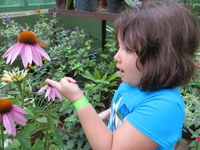Dakota Gardener: Pollinator gardening for children
(Click an image below to view a high-resolution image that can be downloaded)
By April Johnson, Pollinator technician
NDSU Extension
Now that summer is here and students are out of school, adults frequently ask me how to involve youth in pollinator conservation. Though they are wildly popular, I don’t usually recommend that children construct bee houses because of their limited contribution to conservation and high-maintenance demands. Much easier and effective ways exist to encourage children to explore pollinators in the garden.
Teach children not to fear bees. Generally, bees only sting when provoked. Most of the time, bees are too busy foraging for food, nesting, mating or minding their own business to bother us at all. Children can comfortably enjoy the garden alongside bees if they refrain from swatting the bees or interfering with nesting sites. In contrast, wasps and yellowjackets are more aggressive.
Emphasize observation and understanding. Spend time watching pollinators in the garden. Consider starting a nature journal, where children can record observations of any and all of the exciting biological processes taking place in the garden. Keeping a nature journal helps to foster understanding of biology and conservation, and can ignite an interest in the natural sciences.
Create prime pollinator habitat. A collection of plants with different bloom times to provide continuous nectar and pollen resources from April-October is essential in the pollinator garden. NDSU Extension has a series of publications related to pollinator gardening, available at ndsu.ag/pollinators. Other key elements of a pollinator garden that improve habitat are providing water sources and nesting habitat, and limiting insecticide use.
Place shallow containers of water with rocks extending above the waterline for bees and butterflies to drink from, and refresh the water regularly. If you have a shaded space in your garden, consider adding a pond, which will attract pest-controlling predators such as dragonflies, toads and frogs.
North Dakota is home to many species of solitary bees which make nests in the ground, in dry plant stalks, under tufts of dormant grasses, or in cavities within decaying trees or structures. The easiest way to add pollinator habitat to your garden is to leave debris such as trimmed branches, dry grass, and other compostable materials behind in the fall and wait to tidy them up until spring temperatures reach a consistent 50 degrees Fahrenheit.
Be careful in your use of insecticides. Insecticides are often broad spectrum and will kill beneficial and non-target insects just as easily as pests. Limit application time to dusk or later, when most bees and other insect pollinators are safely tucked away in their shelters and avoid spraying blooms.
Biodiversity is the key to a healthy, thriving conservation garden. Attract birds to your garden for nutrient cycling, seed distribution and parasitic wasp control by providing food and shelter such as bird feeders and nesting materials like straw, hair trimmings or string.
For more information on pollinator conservation, citizen science projects, educational opportunities, conservation outreach events, and tips on creating healthy, thriving pollinator gardens, follow NDSU Extension Pollinator Conservation on Facebook.
NDSU Agriculture Communication – July 19, 2023
Source: April Johnson, 701-231-7971, april.johnson.1@ndsu.edu
Editor: Kelli Anderson, 701-231-7881, kelli.c.anderson@ndsu.edu



